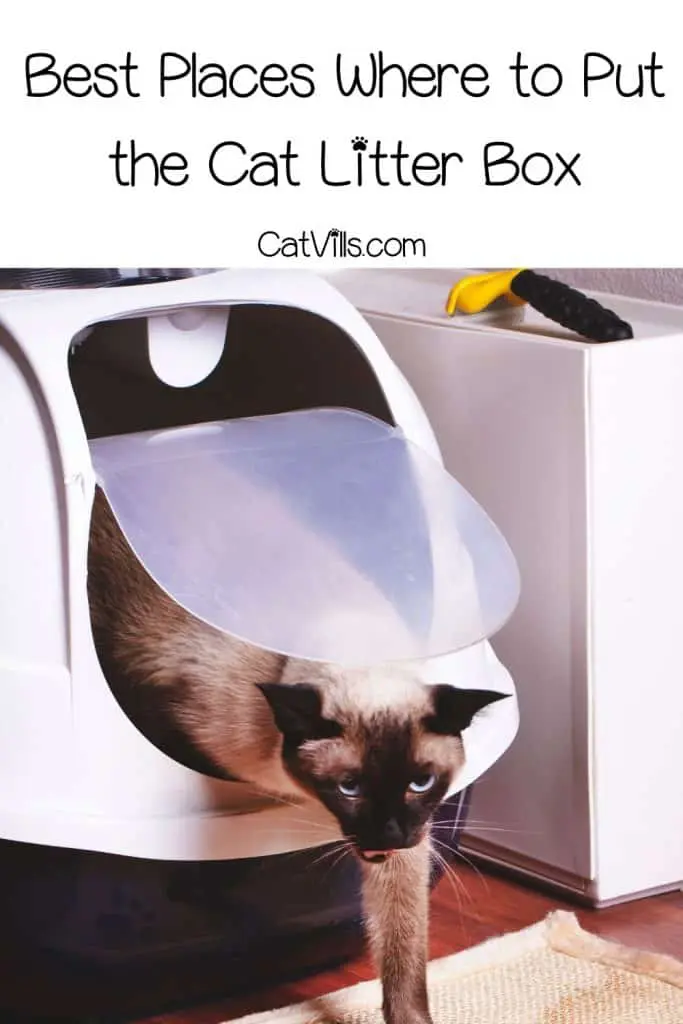Last Updated: 5 months ago
Cat owners often get confused about where to put a litter box containers inside their homes.
But today, we’ll make this confusion disappear with a detailed guide.
It’ll discuss everything needed to select the perfect place for a cat’s litter box.
Your cat will soon have an ideal environment to do its bathroom business.
Where To Put A Litter Box? 9 Best Places
Cats are a lot like humans when it comes to where they like doing their bathroom business. In other words, “cats prefer privacy when they are eliminated.”
So owners need to consider these needs when choosing a location. The location will be safe, accessible, and quiet in an ideal world.
We’ve compiled a few potential options that could meet those qualifications. Hopefully, one of the following areas can be the new home for your cat’s litter box:
1. Bathroom Area

Our first possible location is a master bathroom or guest bathroom. These areas are warm, quiet, and full of bright lights in most cases.
It creates a comfortable environment for humans to be at their most vulnerable. So it makes sense that it’ll fit a cat’s bathroom needs.
If you go with a bathroom space, I’d invest in a litter mat and an enclosed litter box. It’ll help cut down on the messiness and smell.
2. Treasure Chest
While we, personally, don’t consider the contents of the litter boxes in my home to be exactly treasures, dogs would beg to differ.
Regardless, a treasure chest can be a neat way to hide a litter box in plain sight—even as a focal point.
An old steamer trunk or cedar chest is a conversation piece with a secret, although you may not want to use Grandma’s heirloom hope chest. We recommend a thrift trip for this one.
You will need to cut a hole in this big enough for your cat to climb through, and the hole can be anywhere the cat can access easily (the back of the chest is fine as long as it is far enough from the wall for your cat to get in).
3. Living Room

Another popular area to place these boxes is within a living room. After all, it’s often the biggest open space within most houses.
This open space is crucial to helping cats feel comfortable when using a litter box. It’ll allow them to see their surroundings and stay on their toes.
It’s a primal instinct for cats as they always prefer knowing what or who’s coming at them. This sense only increases when inside the litter box.
As a result, your home’s living room can represent a good fit for litter box placement. It’s just a simple matter of finding a quiet corner within it.
4. Shelve It
If you have a good, deep bookshelf or entertainment center, you can sacrifice a lower shelf for the litter box.
This can either be closed in with wood with an access hole cut somewhere into it (be sure you can access the box to clean it as well; you can put the panel on hinges to make this easier) or again with a piece of fabric that your cat can push past.
5. Laundry Room
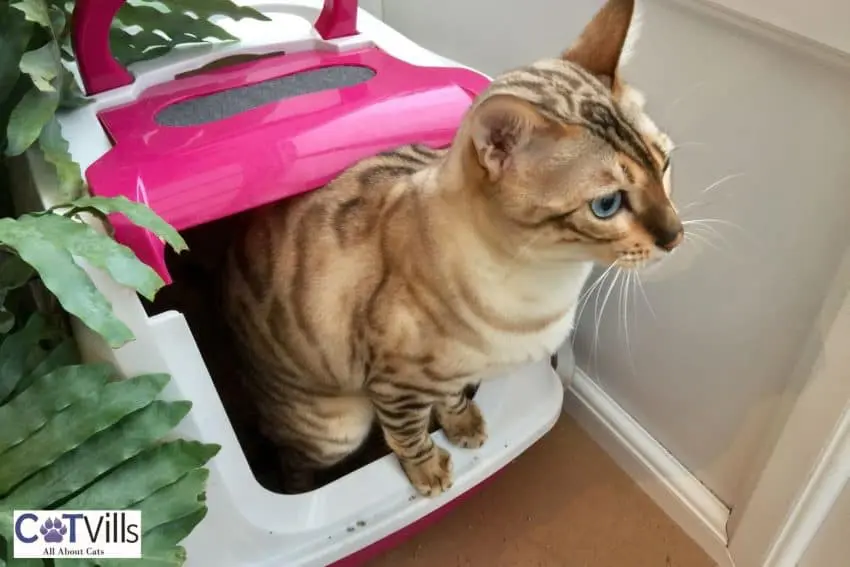
Laundry rooms are often overlooked as quality litter box locations. Cat owners could simply place one within a reachable, isolated corner.
But it’s essential to avoid placing it close to the washer or dryer. These machines are loud enough to startle your cat and make them reluctant to go near it.
For instance, we have an older washer that produces an ungodly sound during cycles. We didn’t consider this issue when first setting up the litter box.
The cat rewarded us with a bathroom accident on the other side of the laundry room. It’s a lesson that we’ll make sure never to forget again.
Obviously, if your washer and dryer are quiet, it becomes a non-issue. You can set one up right next to these machines without thinking twice about it.
6. Wizarding World
One of the coolest things I have seen done with a litter box is to create a space under the stairs for it.
The space for access typically has a sizable door covering it, and your creativity is the only limit to the camouflage.
We’ve seen people paint tiny hobbit holes, dollhouses, and fairy homes on the wall, with a small arch or cat door that blends into the mural designating the entrance to the box.
7. Bedroom
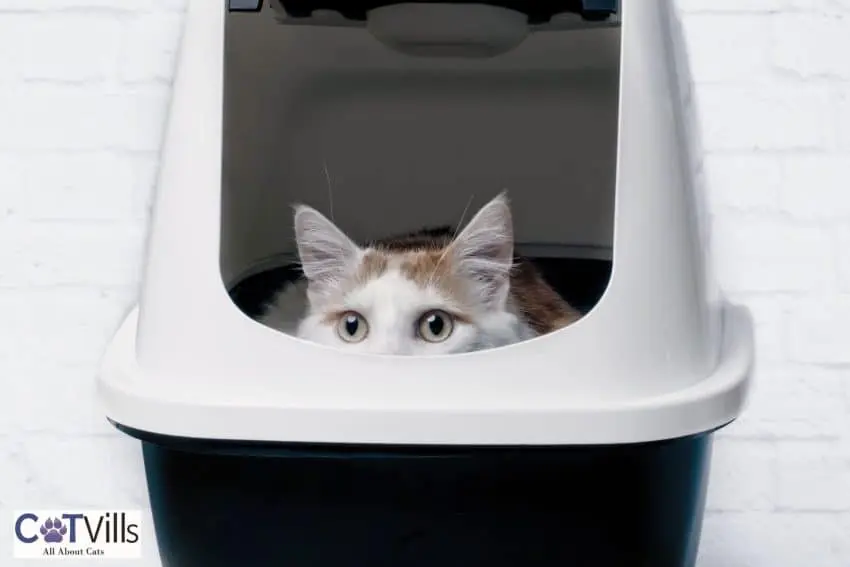
Some owners have found placing the litter box in their bedrooms as a solid choice. It comes down to whether it’s something you don’t mind dealing with inside your bedroom.
As for a cat’s perspective, bedroom litter box placement is undoubtedly ideal. It offers an accessible, spacious (most of the time), and quiet location for them.
If you have limited space, we’d suggest looking at some litter box holders. These products are designed as a piece of furniture but have compartments for litter box storage.
We’ve found these litter box furniture products very helpful for my particular needs. They help conceal the litter and messes while providing storage on its top side.
8. File it Away
If you have an old filing cabinet lying around, you can take out the second drawer from the bottom and put the litter box in the bottom drawer.
A secure screen or plastic grid over the front half of the drawer acts as a means to eliminate some of the excess litter from your cat’s paws and keep your office floor clean.
We’ve seen this same idea used on an old dresser: remove the bottom couple of drawers, pull the fronts off of them, and mount them to a piece of plywood that fits inside the gap.
Use hinges and a latch to reattach the drawer fronts, disguising the now hidden area behind, and cut an entrance for your cat in the side of the dresser.
9. Guest Bedroom
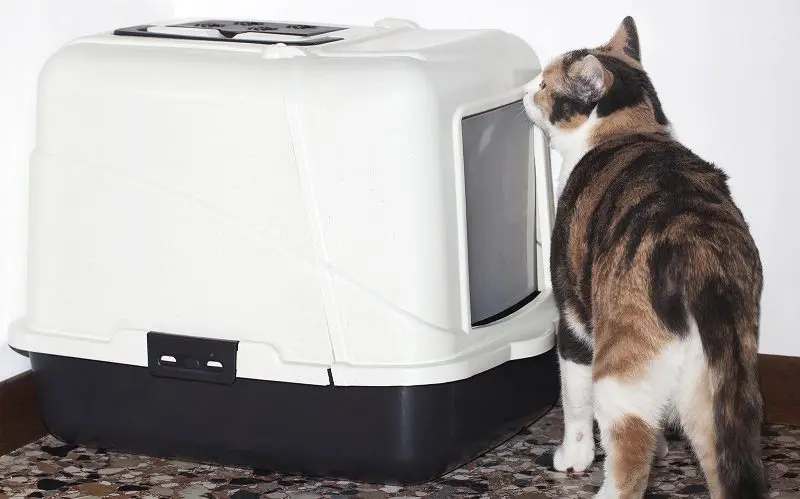
We’re well aware some cat owners don’t view a bedroom cat litter box as acceptable. In these cases, a spare guest room can offer the same benefits.
You’ll need to designate a corner of the spare bedroom for the cat. We’d also place a second litter box in another corner within the guest room.
In doing so, it provides them with a choice and more comfort. Some cats even prefer going number one and number two in different boxes.
What to Avoid When Placing Litter Boxes
Since you know what to look for in suitable locations, let’s discuss what cat owners need to avoid. Here are a few massive situations to avoid when setting up a cat bathroom litter box.
1. Dark Areas
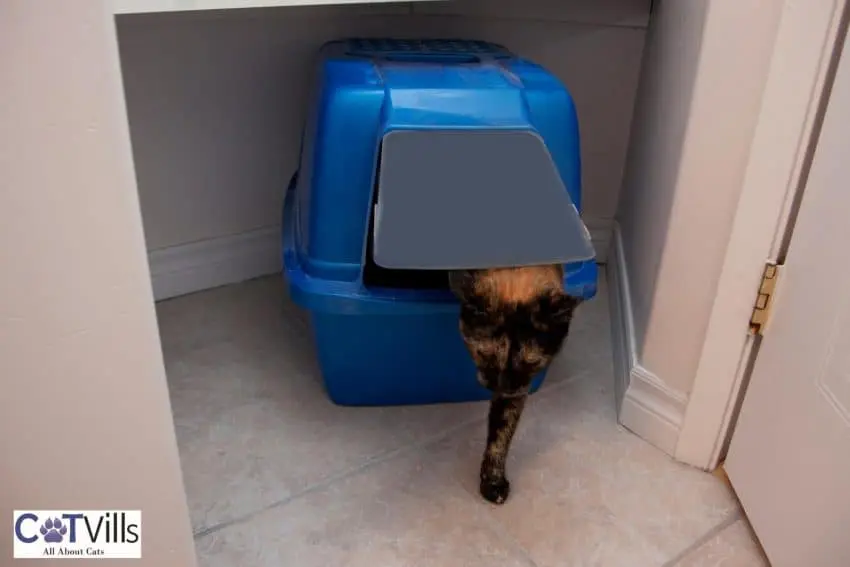
Cats are known for their superior eyesight in the dark. But don’t make them utilize this trait when using the bathroom.
In other words, human beings don’t go to the bathroom without sufficient light. So don’t make your cat do what you wouldn’t want to, as a general courtesy.
Moreover, a well-lit space increases a cat’s comfort within these litter boxes. It helps them feel more at ease when at their most vulnerable.
Investing in a nightlight or keeping the light on at night is another wise move.
2. Noisy Appliances or High-Traffic Areas
As we mentioned earlier, a noisy appliance can scare your cat from using their litter box. Setting up these boxes near loud washers, wall heaters, or dryers is never a good idea.
You’ll also want to avoid heavy foot traffic areas, such as a kitchen or foyer. These louder areas will disrupt your cat’s privacy and significantly hinder their litter box experience.
Dust coming from the litter box is another issue to consider. A cat owner won’t want it around their kitchen where all their food lives.
3. Placing Multiple Litter Boxes Next to Each Other
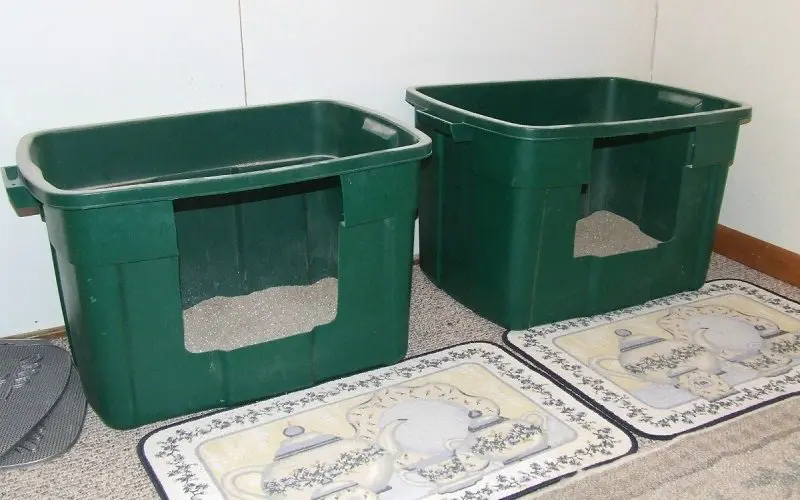
It may seem logical to place multiple litter boxes next to each other, but it’s not a good idea. A cat won’t see any difference between the two boxes.
As a result, there will be more accidents, and waste stuck on the edges or walls. It ends up being a massive hassle and cleaning issue.
We didn’t even mention the privacy, bathroom bullying, and territory issues. But, honestly, putting litter boxes next to each other is only a good idea with enclosed options.
4. Drafty Areas
Heating and AC vents are a few more problematic issues to litter box comfort. These vents often create unpredictable air draws for your cat, which can stress out and startle them.
Due to this, we’d do our best to avoid placing litter boxes near these vents. It’s an easy way to appeal to cats as they’re creatures of habit and hate unpredictable change.
5. Setting the Litter Box Far Away From Everything Else
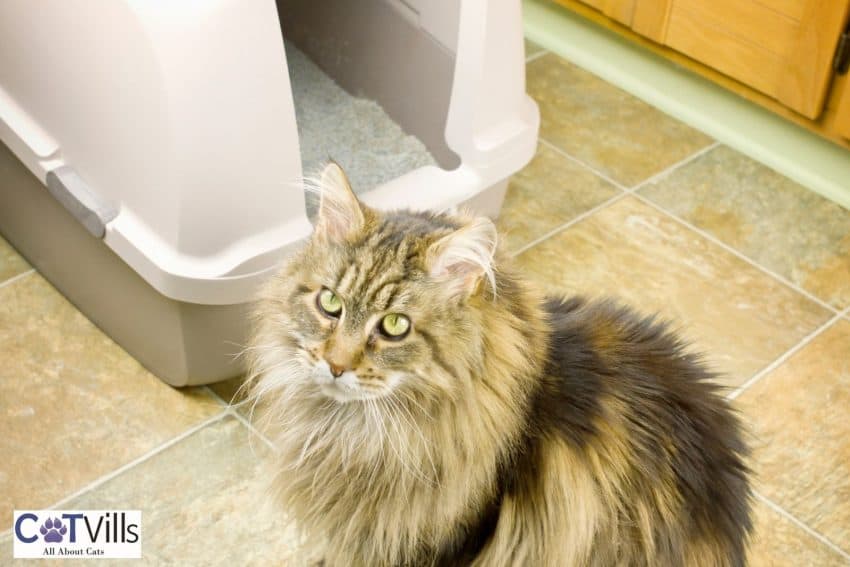
Anyone with a multi-level house needs to have a litter box on each level. But mostly, it’s essential to place one on the level where you spend most of your time.
Cats are more likely to use the bathroom where they feel most comfortable. Basically, we don’t think any cat likes traveling multiple floors to use the bathroom.
So the main litter box needs to be on whatever level your cat spends most of their time. It shouldn’t be in a far away place like a basement or garage.
6. Putting the Box Near Your Cat’s Food and Water
Never set your cat’s food and water near their litter box or boxes.
It’s an unsanitary situation, which no feline will enjoy.
How to Maintain and Monitor Your Cat’s Litter Boxes
Finding a suitable location for your cat’s litter boxes is only half the battle. You’ll also need a detailed understanding of maintaining its cleanliness and monitoring its usage.
Maintaining a Litter Box

Maintaining a cat litter box begins with scooping out the urine and stool. It’s a process that needs to be done daily for effective performance.
Experts point to scooping regular basis being necessary because cats are very clean animals. They prefer a clean litter box to ones with waste already in them.
For example, it’s like choosing between a freshly flushed toilet or a nasty Porta Potty. Of course, you’re going to much rather use the toilet.
You’ll also need to do a complete litter box wash and refill about once per month. This task will help prevent buildups of caked-on litter, bacteria, feces, and other issues.
It’d be best to stick with water and soap when cleaning out these litter boxes. Never use harsh cleaners or bleach as the smell can cause litter box issues and avoidance.
Once cleaned out, you have to let the boxes dry and add fresh litter. Additional complete litter changes might be needed depending on the number of cats and the litter box’s odor.
Monitoring a Litter Box
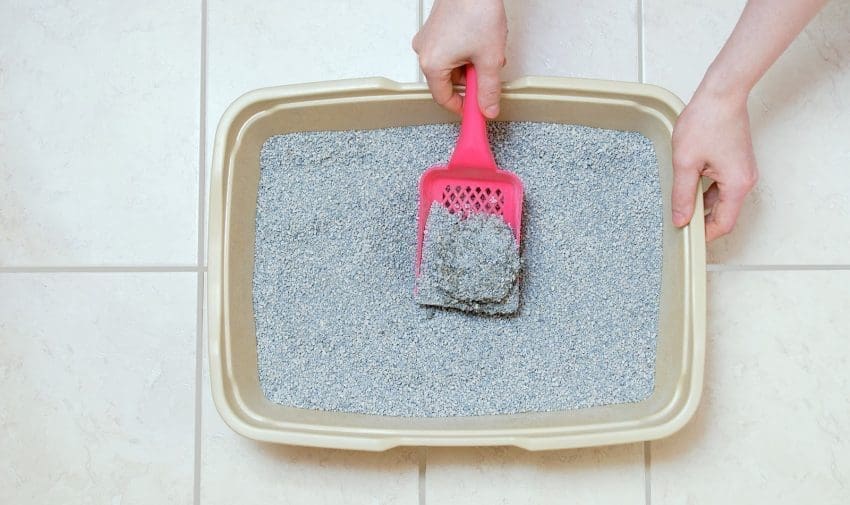
Cat owners need to be aware of changes in their cat’s defecation and urination. After all, these changes can be the clear signs of specific medical issues and behavioral conditions.
It’s why experts emphasize monitoring the size and number of urine/fecal deposits. Plus, it’s not difficult to track as you have to scoop the litter boxes out daily.
FAQs
How Many Litter Boxes Do You Need?
You need one litter box per cat, plus one extra litter box as a general rule of thumb. For instance, a household with three cats would have four litter boxes to meet their extensive bathroom needs.
Do cats know where the litter box is?
Cats don’t automatically know where the litter box is within a household. Instead, cats will pick up this information from other cats or their owner’s training techniques.
Can cats find their litter box if you move it?
Cats will find the litter if you move it based on the smell. But there could be a transition period, especially for cats with eyesight or mobility issues.
Conclusion
We hope this guide helped you answer where to put litter box containers inside your home.
But if you have more questions or concerns, let me know in our comment section.
We’d be happy to continue this conversation and ensure this process isn’t stressful. Thanks for reading!
How about you? Where do you put your cat’s litter box? Please share with us!
Resources:
